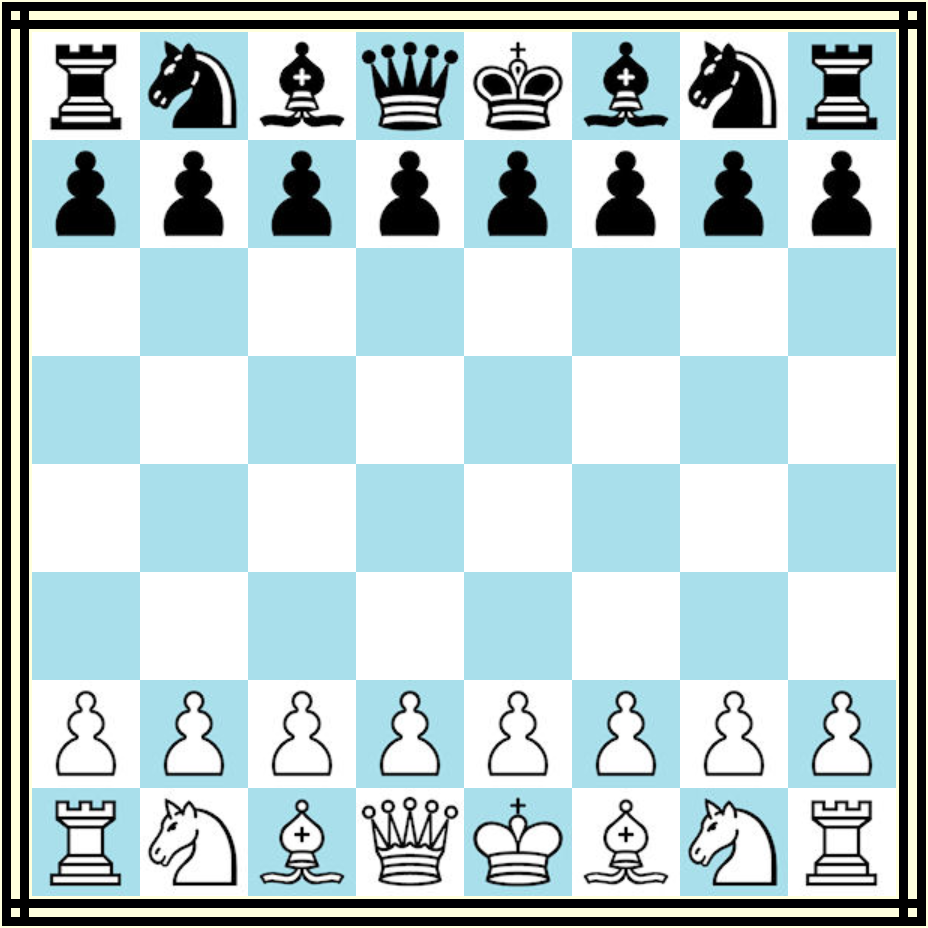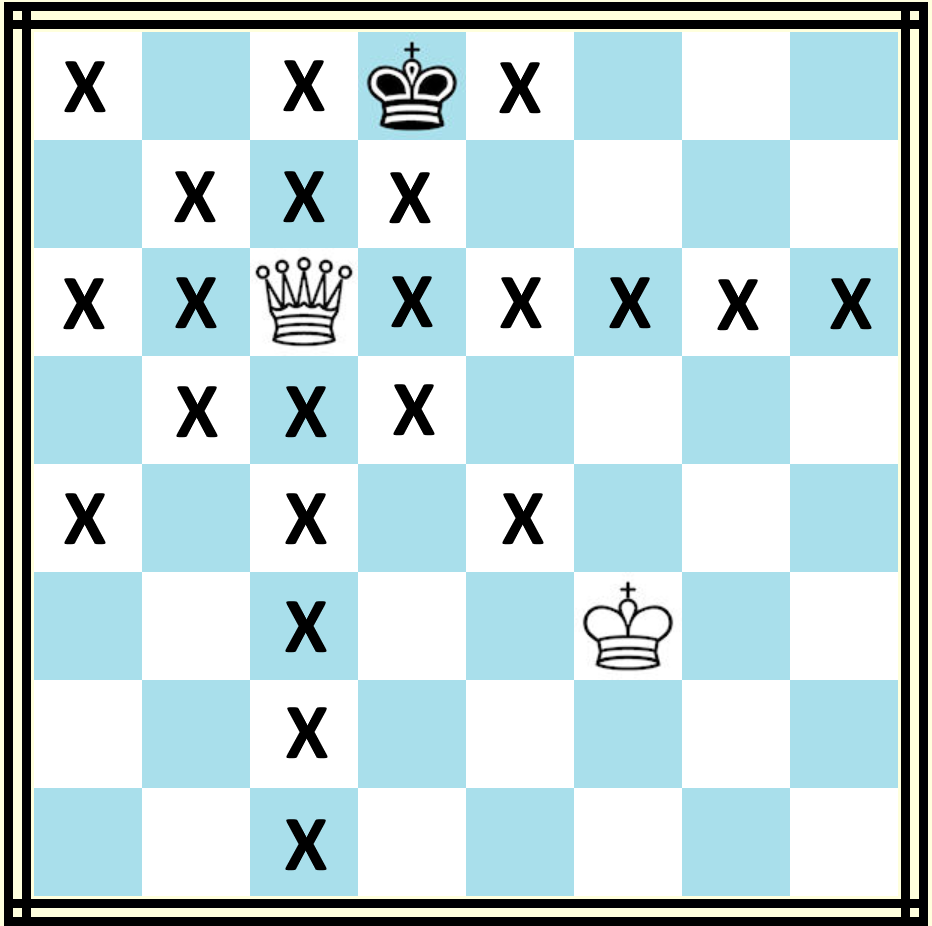The Rules of Chess
In Summary

Chess is played by two players beginning in the position shown above. The White player (the player of the light colored pieces) moves first. Then each player takes a single turn. In fact, a player must move in turn. In other words a move cannot be skipped.
When setting up the pieces, keep in mind two things. The light colored square goes on the player's right, and Queens go on their color next to the Kings on the center files.
You may not move a piece to a square already occupied by one of your own pieces. You may capture an opposing piece by replacing that piece with one of your own pieces, if it can legally move there.

The King is the most important piece. When it is trapped so it cannot move without being captured, then the game is lost. This trap is called checkmate. The King can move one square in any direction. A King can never move into check, or onto a square where it can be captured by an opponent's piece. If a King is not in check, and no other legal move is possible, then the position is said to be in stalemate. A stalemated game is a draw, or a tie. Legal King moves are marked with an X in the diagram above.

The Queen is the most powerful piece because she can move to any square in any direction as long as her path is not blocked. Her range and the ability to attack many pieces at once are the source of her power.

The Rook is a very powerful piece because it can move to any square along its file or row as long as its path is not blocked. Its range is the source of its power.

The Bishop is a powerful piece because it can move to any square along its diagonals as long as its path is not blocked. Its range is the source of its power.

The Knight is nearly as powerful as the Bishop not because of its range, but because it is the only piece that can hop over other pieces in an L-shaped path. This ability makes it particularly powerful in the early stage of a game when the board is crowded with pieces.

The Pawn is the least powerful piece because of its poor mobility. It may move only one square forward if its path is not blocked. However, it may move as an option one or two squares forward on its first move only. It may capture only diagonally one square. It may not capture forward. It may not move backward. The lowly Pawn usually does not last long, but if it is able to reach the 8th row or rank, then it can promote itself to any other piece except the King. A Pawn thus promoted is replaced by that piece. Therefore, it is possible to have more than one Queen, or two Rooks, Bishops, or Knights on the board at one time.

A player may capture another player's pawn in passing (or an many chess players say in French "En Passant") under very specific circumstances. This move is designed to prevent a player from taking advantage of the two-square first-move rule for pawns which might allow them to pass their opponent's pawn(s) without a chance to capture.
The capture is made exactly as if the pawn moved only one square on the first move. In the picture, Black's pawn moved up two squares as is its right. White captured the pawn by removing it from the board and placing the passed white pawn on the square marked ep before playing another move. This move, like any other, is optional and can occur as often as a similar situation arises between pawns.

Here Black is castled short or on the King side. White is uncastled.

Here Black is castled long or on the Queen side. White is uncastled.
Castling is an important move in chess. It allows a player to quickly move both the King to safety and the Rook to the center for battle. For this reason, wise players carefully guard their ability to castle and usually castle early in the game. Likewise, clever players will attempt to prevent their opponent from castling.
When castling the player moves his King two squares toward one of the player's Rooks and moves that Rook to the opposite side of the King. A player may not castle if either the King or the Rook involved have already moved. Also, the King may not castle out of, through, or into check. There must be no pieces between the King and Rook when castling.
The Objective in Chess
The primary objective in chess is to checkmate your opponent's King. When a King cannot avoid capture then it is checkmated and the game is immediately over. If a King is threatened with capture, but has a means to escape, then it is said to be in check. A King cannot move into check, and if in check must move out of check immediately.
- Capture the checking piece.
- Block the line of attack by placing one of your own pieces between the checking piece and the King. (Of course, a Knight cannot be blocked.)
- Move the King away from check.
How to Move Out of Check
If a King is not in check, and no other legal move is possible, then the position is said to be in stalemate. A stalemated game is a draw, or a tie.
If 50 moves are made without the advance of a pawn or the capture of a piece, then a game can be claimed as a draw.
There is no "perpetual check" rule. (See the 50 move rule, or three-time repetition of position rule.)
If you touch a piece intentionally during a formal tournament game, and it can be legally moved, then you must move it. This rule is often disregarded in casual games.
If the same position occurs 3 times, then a game can be claimed as a draw.
A move is made up of two half moves or plies; one by white and one by black.
- While common practice among amateur chess players, calling "check" or "checkmate" is at least rude, and at most illegal. Players who hear such calls may object to the interruption of their concentration (I would) and call a Tournament Director (TD). The TD will tell the caller that verbal calls bother all listeners. Then if the caller does it again, he or she may be penalized.
- A verbal call of check or checkmate is an insult to the listener, because the caller presumes that the listener is so inattentive that he or she will not notice their hanging King. This is why players who call check or checkmate are rude.
- Chess player's should allow their opponent to discover that they are in check or checkmate. If a chess player happens to miss the fact they are in check or checkmate, and makes an illegal move, then their opponent should point out that an illegal move was made. There is no requirement to explain why the move is illegal. One must only point out that an illegal move was made. It is not the responsibility of either player to explain the rules of chess to anyone during a game. Furthermore, it is out right illegal for anyone other than the players or the TD to explain rules, or otherwise interfere with a game. If the player who made the illegal move does not believe the move was illegal, then either player may ask a TD to make an official ruling. Of course, any qualified third party may rule on a move in a casual chess game.
- Simply stated, you should not call or tolerate a call of check or checkmate when playing quality chess.
Do NOT call out "check" or "checkmate."
You may obtain the United States Chess Federation Official Rules of Chess from the United States Chess Federation.